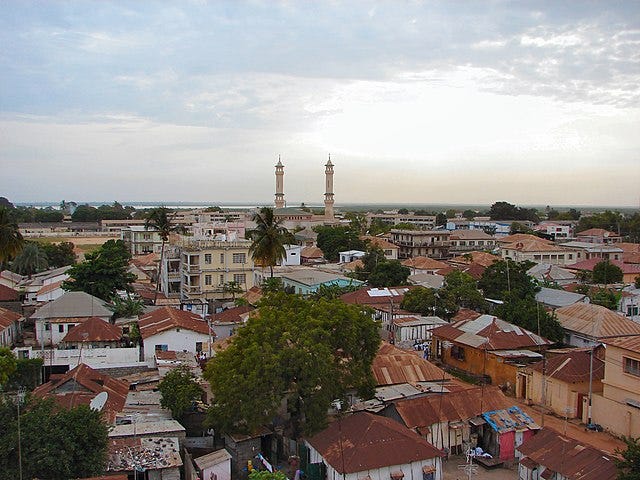Table of Contents
Introduction
Nestled along the banks of the River Gambia, The Gambia is the smallest country in mainland Africa. But despite its tiny size, it boasts a vibrant culture, diverse landscapes, and natural wonders waiting to be explored. From bustling capital markets to lush inland forests, The Gambia entices visitors seeking an authentic West African experience. The welcoming spirit of the Gambian people shines through in the nation’s rich artistic traditions and distinctive cuisine. Adventure-seekers can trek through protected wildlife reserves, while beach lovers can bask along Atlantic coastlines. Read on to discover the many charms drawing travelers to this captivating jewel of a nation.
Explore the Capital City of Banjul
Banjul, the capital of The Gambia, offers a fascinating introduction to urban life in the country. The city displays distinct architecture blending African, Islamic, and colonial influences. Albert Market provides a prime spot to pick up unique souvenirs like bold patterned fabrics, handcrafted masks, and fragrant spices. The National Museum immerses you in the history of the region, from ancient stone tools to the colonial era. Keep an eye out for energy-filled dance troupes performing to the rhythmic beats of drums along the streets.
Discover the Natural Beauty
Beyond the city, The Gambia’s natural splendor shines through in its wealth of wildlife and ecosystems. River Gambia National Park protects mangrove swamps and diverse habitats along its namesake, allowing breathtaking boat tours to spot everything from monitor lizards to dexterous chimpanzees. The Chimpanzee Rehabilitation Project rescues and provides sanctuary for orphaned chimps on Baboon Island. In the coastal Bijilo Forest Park, take a stroll along elevated walkways through marshy woodlands out to Monkey Island, where you can observe mischievous monkeys up close.
Relax on Picture-Perfect Beaches
What’s a trip to the coast without lounging on the beach? The Gambia’s Atlantic shoreline obliges with seemingly endless options. Cape Point showcases dramatic sloping cliffs leading down to the ocean. In the fishing village of Bakau, try some freshly grilled fish while watching local pirogues sail along the surf. Further south, Cape Point and Gunjur lure surfers and snorkelers to ride waves and spy on dolphins. The quiet beaches of Sanyang or Kartong provide ideal settings for complete relaxation under the tropical sun.
Experience Rich Cultural Traditions
Gambian culture reveals itself through many rich artistic and oral traditions. You may be lucky enough to catch a kankurang ritual dance featuring masks and costumes meant to maintain communication between humans and spirits. Fabric dyeing and weaving are revered skills, used to create the vibrantly patterned fabrics tailored into clothing and tapestries. Storytelling, proverbs, and oral histories allow each generation to pass on folk tales that form an integral part of Gambian heritage. Wrestling has been a favorite Gambian sport for centuries, with competitive matches drawing huge communal audiences.
Sample the Diverse Cuisine
Food lovers will find much to savor in Gambian cuisine. A staple dish is benachin, hearty rice cooked in a single pot along with vegetables, chicken, or fish. Domoda features a thick peanut sauce served over rice. Meats like oxtail and lamb may feature in stews and tangines. Due to the abundant coastline, seafood features prominently – try barracuda in a spicy sauce or shellfish like oysters fresh from the casings. Exotic fruits like the vitamin C-rich baobab and doussou offer natural sweetness.
Trek and Explore Inland Regions
Beyond the coast, delve deeper into the Gambian landscape by heading inland. Kiang West National Park encompasses savanna, woodlands, and wetlands. Keep watch for antelope, warthogs, baboons and over 300 species of birds. The megalithic Wassu Stone Circles date back over 1000 years. Here, ancient burial sites feature mysterious carved stones set in circular patterns. Further north, Niumi National Park offers prime panoramic birdwatching opportunities in tranquil riverine settings.
Consider an Eco-Tourism Trip
For travelers keen to directly support local communities, eco-tourism provides memorable and meaningful experiences. Stay in community-run camps and lodges to get a taste of village life. Due to reliance on nature, locals have adopted sustainable environmental practices. Visitors can take cooking classes, go fishing with locals, participate in wildlife conservation, and gain exposure to everyday Gambian occupations. The tourism revenue helps fund schools, health clinics and other vital infrastructure.
Conclusion
From verdant forests to lively markets to palm-lined beaches, The Gambia offers visitors a wide range of natural and cultural wonders to discover. The hospitable Gambian people warmly welcome foreigners to immerse themselves in their nation’s food, art, stories and customs. Whether you seek wildlife encounters, village stays or total beachfront relaxation, this tiny West African nation promises grand adventures. So pack your bags, ready your camera and let your journey unfold across the vibrant landscapes of The Gambia.
FAQs about Travel in The Gambia
Is it safe to travel in The Gambia?
Yes, The Gambia is generally considered safe for travelers. However, you should exercise normal precautions as petty crimes like pickpocketing can occur. Avoid carrying valuables, don’t walk alone at night, and use authorized taxis.
When is the best time to visit The Gambia?
The dry season between November to May sees ideal weather in the mid-70s to mid-80s F. The rainy season from June to October can be hot and humid.
What vaccines do I need when traveling to The Gambia?
Recommended vaccines include Hepatitis A, Typhoid, Tetanus, and Yellow Fever. Malaria prevention medication is suggested.
What currency is used in The Gambia?
The official currency is the Dalasi. US dollars and Euros can sometimes be used for payment.
What languages are spoken in The Gambia?
English is the official language and Mandinka is the most common native language. Wolof, Fula, and Jola are also spoken.
